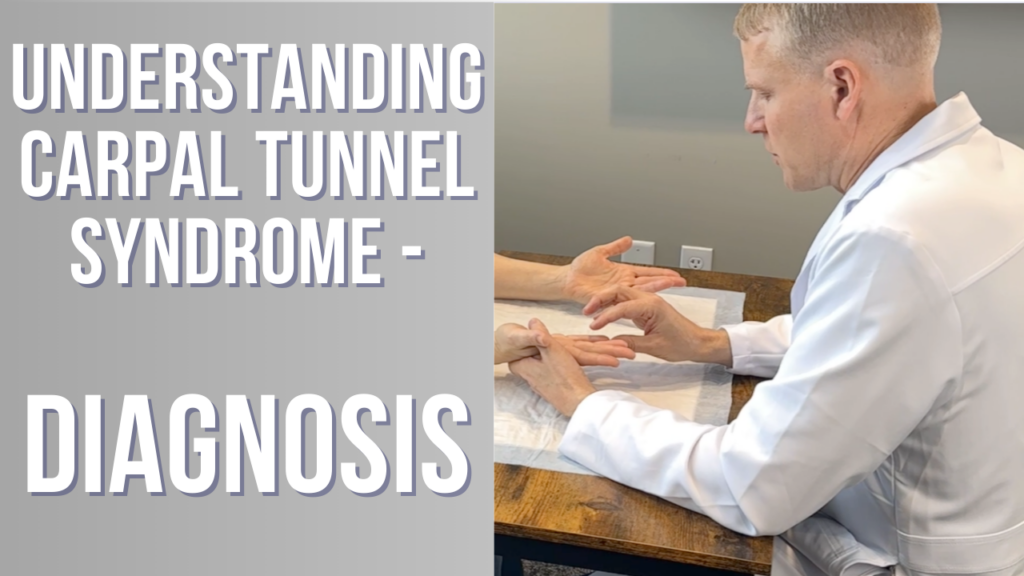Have you ever wondered if you have carpal tunnel syndrome? Your hands and wrists hold the answer, but how can you hear what they’re telling you?
Hello, everyone, and welcome back to the Elite Carpal Tunnel Channel. I’m Dr. Travis Peterson, a board certified orthopedic surgeon with subspecialty certification in hand surgery. Today, we’re diving into understanding how carpal tunnel syndrome or CTS is diagnosed. We’ll cover what you can expect during the diagnostic process. But before we get started, don’t forget to hit that subscribe button and ring the notification bell so you never miss an update from us! As always, this video is informational only and should not substitute for qualified professional evaluation.
Introduction to Carpal Tunnel Syndrome
First things first, what is Carpal Tunnel Syndrome? Well, it’s a common condition that can cause pain, numbness, and tingling in the hand and wrist, due to pressure on the median nerve in the carpal tunnel. But how do you know if you have it? Let’s find out.
Clinical Diagnosis
First and foremost, carpal tunnel syndrome is what we refer to as a clinical diagnosis. What does this mean? Simply stated, there is no single test that confirms the diagnosis of carpal tunnel syndrome. Instead, the diagnosis is made by gathering several pieces of information and deciding if they are consistent with a diagnosis of carpal tunnel syndrome. In a way it is like trying to put a puzzle together. As pieces are sorted, organized, and gradually pieced together; the picture begins to come into view. We eventually have enough pieces fit together to be able to recognize the image. Even before every last piece is placed, we can get reasonable clarity on the picture. Diagnosing carpal tunnel syndrome is similar. We don’t need to have every single piece in place to be able to see the picture, but we do need to have enough pieces to be confident we are seeing the picture accurately. That’s what we do when we diagnose carpal tunnel syndrome. We gather and fit together enough clinical details to get a clear view of the diagnosis. Making this type of diagnosis is significantly enhanced by the experience level of the one making the diagnosis. Experience matters.
So what are the pieces we are trying to sort and organize in diagnosing carpal tunnel syndrome? Let’s take a couple minutes to discuss the pieces.
Symptom Recognition
For most, the diagnostic process begins with you. You start noticing the symptoms in your hands and wonder if you might be developing carpal tunnel syndrome. Many turn to family and friends to discuss their symptoms, as well as Google and YouTube. You ask questions and search for answers to understand if what you’re experiencing is indeed carpal tunnel or not.
Medical History
At some point you may decide that you need some assistance beyond family, friends, and Dr. Google. The question then becomes who should you see? While you can certainly start with your primary care provider, only some insurances require a referral; so in many cases it is not necessary to see your primary care provider and you can come directly to the specialist. This can save time and expense. Check your insurance plan to see if you need a referral. At Elite Carpal Tunnel the first step in the diagnostic process is a discussion of your symptoms. I ask patients questions to understand what is going on. Commonly discussed questions are things like: “What are the symptoms you’re experiencing? When did they start? How severe are they? When do they happen. Are there any activities or factors that make them better or worse? These and other questions are pieces of the diagnostic puzzle.
Physical Examination
Next, I perform a physical examination. I look for physical signs like diminished sensation, tenderness, or muscle atrophy in the hand. Various physical exam tests have been used to try to assist in making the diagnosis. The diagnostic value of various tests has been questioned over the years. In addition to sensory examination, Tinel’s and Phalen’s tests, are commonly administered to see if these provoke symptoms of hand numbness.
Tinel’s test—This is done by tapping over the course of the median nerve as it passes through the carpal tunnel. A positive test is one in which zinging, tingling sensations are felt in the hand with this tapping over the nerve.
Phalen’s test—This test is performed by holding the wrists of the patient in a flexed position for a period of time to see if this will recreate the symptoms of numbness and tingling in the hand.
None of these is definitive in diagnosis, but physical exam findings are one of the diagnostic puzzle pieces.
Nerve Conduction Studies and Electromyography
In many cases, medical history and physical examination are enough to make an accurate diagnosis. In cases where there is uncertainty, I may recommend nerve conduction studies (NCS) with electromyography (EMG) to fully confirm the diagnosis. When needed, I will usually refer patients to have this testing by a specialist like a neurologist, physiatrist, or therapist trained in administration of these studies and has the necessary equipment. This test helps to evaluate the health of nerves which function as the “electrical wires” of the body.
This test has two main components:
First, is nerve conduction velocity or NCV testing. This tests how well nerve signals are conducted down a nerve. In the case of carpal tunnel syndrome, the nerve examined is the median nerve. Electrodes are placed on the skin on your arm. Shock signals (which don’t hurt) are then sent down the nerve to see if there are any places where the nerve signal is slowed or decreased in size which could indicate an area of nerve compression.
Second is the electromyogram or EMG. In this test, a small needle electrode is placed within several muscles of the arm and neck to test the electrical signals within the muscle itself. These electrodes can pick up on normal as well as abnormal signals that might indicate a problem with nerve communication with the muscle or a problem with the muscle itself.
Both of these tests can be abnormal in patients with carpal tunnel syndrome. They can also pick up on other possible problems like cubital tunnel syndrome, pinched nerves in the neck, or other neurologic problems. Both can also be somewhat uncomfortable. You probably wouldn’t choose to do it for fun, but it can assist in the diagnosis of carpal tunnel syndrome.
When needed, scheduling and waiting for this testing can often be a bottleneck that slows the diagnostic and treatment process. We will counsel together to determine the value of this testing in our diagnostic puzzle, and try to balance finding a provider near you with finding a provider who can get you in quickly. This can sometimes be a challenge.
Imaging
In some cases, imaging tests like x-rays, ultrasound, or MRI may be used in the workup of hand numbness and to rule out other conditions that can mimic or overlap with CTS symptoms.
Differential Diagnosis
It’s important to rule out other conditions that can cause similar symptoms, like neck issues or other neurologic problems. This might involve additional tests or consultations with specialists.
CONCLUSION
So, there you have it! These are the pieces that help make up the carpal tunnel syndrome diagnosis puzzle. If you suspect you may have CTS or are experiencing symptoms, don’t hesitate to seek medical advice. Remember, early diagnosis and treatment can make a big difference in managing this condition. Please feel free to leave a comment below. Share your experience and thoughts.
Thanks for watching, and if you found this video helpful, please give it a thumbs up and share it with others who might benefit. We’ll see you in the next video!
Take care and stay healthy, everyone. Until next time!

